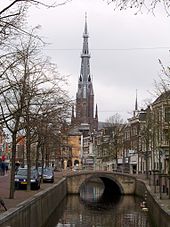Leeuwarden
![]()
The title of this article is ambiguous. For the watchmaker of the same name, see Egbert Jans van Leeuwarden.
Leeuwarden [ˈleːu̯ˌʋɑrdə(n)] ( ![]() West Frisian Ljouwert (
West Frisian Ljouwert (![]() )) is a city in the Dutch province of Friesland and the administrative seat of the province. In 2018, Leeuwarden was the European Capital of Culture, together with Valletta (Malta).
)) is a city in the Dutch province of Friesland and the administrative seat of the province. In 2018, Leeuwarden was the European Capital of Culture, together with Valletta (Malta).
Geography
Leeuwarden is located in the province of Friesland in the north of the Netherlands.
History
The area has been settled since at least the 10th century. Recent excavations possibly represent remains of dwellings from the 2nd century.
Originally there were three terpen (terps) here, on which the three villages of Oldehove, Nijehove and Hoek were situated. In the 14th and 15th centuries they grew into the new town of Leeuwarden. The town was granted town rights in 1435. Due to its location on the Middelzee, a bay of the Wadden Sea, Leeuwarden was a busy trading centre until the waterway dried up in the 15th century. After that, the town remained only of regional importance as a cattle market for the surrounding meadowlands and, after submitting to Albrecht of Saxony in 1498 and recognising him as hereditary governor of Friesland, as the administrative centre of Friesland.
Around 1600, Leeuwarden was temporarily a large city, even by the standards of the time, with 15,000 inhabitants. From the 16th century onwards, Leeuwarden was the seat of the governor of the province of Friesland, one of the seven provinces of the Dutch Republic. Friesland, together with Groningen, had its own governors, unlike the five other Gaue. One of these was Johann Wilhelm Friso of Nassau-Dietz, who was succeeded by his widow Marie Luise of Hesse-Kassel after his early accidental death in 1711. This princess, who was very popular with the Frisians and was called Marijke Meu (Aunt Maria), acquired a large house in the town in 1731, which has since been called Princessehof. Marijke Meu collected precious porcelain; her collection is still owned by the Princessehof Ceramics Museum, which is located in the same building.
In the 18th and early 19th century Leeuwarden came to new prosperity through the connection to the railway network (around 1868). In 1901, the city had 32,203 inhabitants.
During World War II, the town was occupied by the German Wehrmacht from 1940 until it was captured by the Royal Canadian Dragoons on April 15, 1945.
· 
Stadhouderlijk Hof (Court of the governor)
· 
Princessehof (of Princess Maria)
· 
Waag

Voorstreek with tower of the St. Boniface church
Search within the encyclopedia